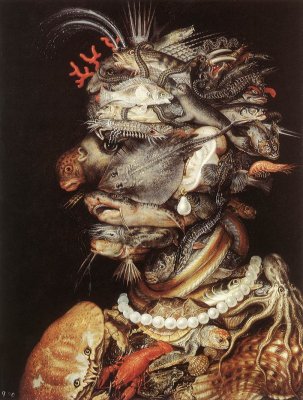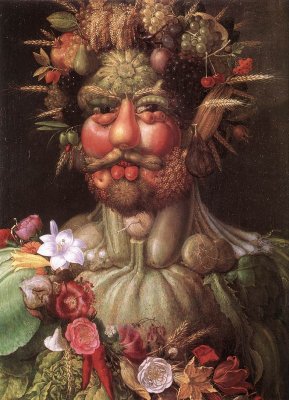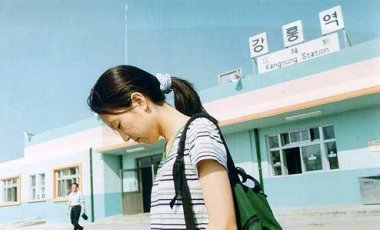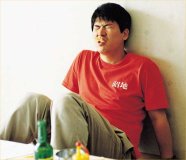Scene 1 - In the street
Her: What are you thinking about?
Him: Arcimboldo.
Her: Sorry?
 Him: You know Guiseppe Arcimboldo, the guy who used to paint portraits with vegetables, flowers or even fish.
Him: You know Guiseppe Arcimboldo, the guy who used to paint portraits with vegetables, flowers or even fish.
Her: Of course, everyone knows Arcimboldo. He was born in Milan in the 1520's and he worked in Prague for the royal court. I find his paintings quite disgusting actually. But we are just now walking out of our third Hong Sang-soo film in three days and I don't see what makes you think of Arcimboldo!
Him: I guess you are right, but forget people who tell you that there is a specific context for everything. We are just walking in some street of Paris after seeing a Korean film, what's the point of contexts ? As I've said many times, I am not talking science, I am just trying to understand what I feel in front of a piece of art...
Her: There you go again... but I still don't see what Hong Sang-soo and Arcimboldo have in common even in a street in Paris!
Him: I believe that both of them are trying to represent reality with details. Not only that, but I believe that they share the same conception of details.
Her: What conception ?
Him: Any detail can stand on its own as a unity, but at the same time it is also part of a bigger unity. You remember one of the most famous paintings of Arcimboldo "Rodolphe II en Vertumus". Rodolphe II's nose is made out of a pear. As you see it, it is a pear, a single fruit, but it is also a nose on a face.
Her: Yes I remember this portrait, it's actually one of the most repulsive ones! His neck is made out of two cucumbers!
Him: That's exactly what I mean. You can take this neck-cucumber out of this portrait and use it as a nose-cucumber elsewhere. It's a possibility, but then it's not Rudolphe II anymore, it's somebody else. Any fruit or vegetable can make an infinite number of faces. Just like in a collage. Every detail has a different meaning depending where it's put. With Hong Sang-soo it's the same, the story is built on signs, traces from one sequence to another, just like motifs on a carpet, forming not exactly a story but... a movie I guess.
 Her: This I can understand, because when I saw The Power of Kangwon Province I had the feeling that the story could take different turns all the time.
Her: This I can understand, because when I saw The Power of Kangwon Province I had the feeling that the story could take different turns all the time.
Him: Yes, that's the point, it depends what details you want to focus on. Do you remember that The Power of Kangwon Province starts with the girl on the train. At the station she meets two other friends. One of them stays in the minbak room and reads a poem by Rimbaud.
Her: "Et j'irai loin bien loin, comme un bohémien..." It sounds good in Korean too you know. This scene raises interrogations on the character that the film doesn't answer. I thought this character could have been more developed. But then the film would have taken a totally different form... so it's not frustrating at all.
Him: Just as if you used the cucumber as a nose instead of a neck... What's important is that every character has this potential: they are all details on a big form, but they have the potential to change the big form. It's all a paradox and that's what's beautiful about their situation. They are miniatures, insignificant pieces of this big puzzle, and yet each of them has the power to change the story. They have a life out of this story, they are secondary here but also individuals. In Kangwon we follow the girl with the blue scrunchy, but you are right, it could be someone else.
Her: You don't notice the blue scrunchy in the first scene when she is in the train...
Him: Just as you don't pay attention to the guy who slides his way between the passengers and orders beers and dried squids. But then the blue scrunchy becomes noticeable, especially when she gets so drunk that she spends a long time picking it up.
Her: Then she forgets it when she goes to the bathroom in the motel.
Him: In the second half of the movie, we are told the story of another character who travels in Kangwon Province. And it's only in the end that we realize, thanks to the blue scrunchy, the connection between the two stories.
Her: You are going too far: I would have recognized her without the scrunchy.
 Him: Yes, maybe, but you need this object as a center. Suddenly every thing seems to take its right place around this scrunchy. It attracts all the pieces of the story like a small magnet... yet you are right it's still only an insignificant scrunchy, nothing more. It doesn't symbolize or represent anything.
Him: Yes, maybe, but you need this object as a center. Suddenly every thing seems to take its right place around this scrunchy. It attracts all the pieces of the story like a small magnet... yet you are right it's still only an insignificant scrunchy, nothing more. It doesn't symbolize or represent anything.
Her: Now that you mention it, lots of objects seem to travel in Hong's film : the umbrella in Kangwon, the wallets in The Day the Pig Fell Into the Well, the gloves in Virgin Stripped Bare by her Bachelors. The objects are like the characters; they all take different meanings depending on how you look at them.
Him: Not only objects. You haven't seen Turning Gate yet ?
Her: No not yet.
Him: In Turning Gate an actor meets a young and beautiful girl. I usually like girls in Hong Sang-soo's films, you know...
Her: ...
Him: Anyway, she remembers him, but he doesn't remember her. They are in some restaurant and she is shaking her hand near her face, using it as a fan, because it's so hot. (In Korea the meat is cooked right on the table). As he sees her doing this movement he suddenly remembers her. One small meaningless movement can bring the entire story back to the surface.
